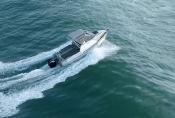Maritime New Zealand Bar Crossing Guidance

25.07.2017

Maritime New Zealand Guidance On Crossing The Bar
Maritime New Zealand have guidance information and resources for skippers and crew when crossing any bar or river entrance.
Extreme caution must be exercised when crossing bars. Conditions prevailing on a bar, or in river approaches, may cause sudden steep and often breaking seas. The national code of practice addresses concerns over fatalities, mainly to the crew of fishing vessels, on bar harbours.
After extensive consultation with all sectors of the maritime industry, a group made up of bar harbour harbourmasters, fishing industry representatives and Maritime New Zealand has developed the following code of practice for bar crossings.
The purpose of the ‘national code of practice’ is to provide clear guidelines to the skipper and crew of all vessels regarding safe and prudent practice when attempting to cross any bar or river entrance.
Cautions
Extreme caution must be exercised when crossing bars. Conditions prevailing on a bar or in river approaches may cause unusually sudden steep and often breaking seas. Conditions change quickly and unpredictably. The skipper's experience and the vessel type should be taken into account when a bar crossing is considered. However, no amount of experience or boat type makes crossing a bar SAFE when the conditions are marginal or adverse. No situation warrants taking the risk, so if in doubt “STAY OUT”.
Before leaving harbour, a skipper must assess conditions on the bar. Skippers must be aware that a rapid change in conditions might prevent a safe return to harbour. Craft unable to weather adverse seas outside the bar should not leave port. Those vessels leaving for longer trips should ensure they have adequate reserve fuel and provisions to enable the vessel to remain at sea and/or divert to another port should adverse bar conditions prevail on their return.
Ensure that your vessel has sufficient stability. All vessels must be in a stable condition. Skippers should be aware of all the factors that determine a vessel's stability including:
- The free surface effect of liquids and loose fish.
- Additional weights on deck, including portable ice slurry bins and fuel containers.
- The loss of stability that occurs if deck enclosures or bins suddenly fill with water.
- Modifications to a vessel may be detrimental to its stability.
- The vessel's statical stability should have been calculated after such alterations.
- The movement of weights within the vessel, including people.
Skippers should be aware that all bars have areas of broken water containing air, which can severely reduce the stability and handling of a vessel. In marginal conditions, night time crossings are more hazardous. Vessels attempting to cross a bar at or near low water are more likely to experience adverse conditions than at high water.
Prudent Practice
Maritime New Zealand - How to Cross the Bar VIDEO >
Maritime New Zealand - Commercial >
Effective communication must be established before attempting a crossing between the skipper and the harbourmaster or if unavailable, another responsible person.
All skippers operating to and from bar harbours should obtain relevant up to date information and a weather report pertinent to the area before crossing the bar, and take into account that information.
Stay at a safe distance offshore until a report on the prevailing bar conditions has been obtained from the harbourmaster or, if unavailable, another responsible person inside the harbour. If in doubt "STAY OUT".
Skippers should ensure that all deck openings, hatches and doors are securely battened down or closed, particularly off-centre line hatchways. Freeing ports should be checked that they are clear and operating. Loose gear on deck including ice-slurry bins and their lids should be secured.
Before crossing any bar entrance, skippers should ensure that everyone on board is awake and dressed.
Ensure lifesaving equipment is easily accessible and ready for immediate use. Every person should wear a lifejacket or personal flotation device (PFD) of an appropriate size, particularly children. There are many approved inflatable lifejackets that are easy and comfortable to wear.
Approaches should be made at a moderate speed in order that a skipper might increase or slacken speed in order to steer out of trouble.
A lookout watching astern should be posted to keep the helmsman informed of the approach of dangerous building swells.
In the interests of safety and manoeuvrability, the skipper should ensure the preceding vessel is well clear of the bar before proceeding.
Once across the bar, the skipper should confirm successful crossing with the harbourmaster or, if unavailable, another responsible person.
A “responsible person” is a person with relevant experience and/or expertise, in whom the skipper has confidence, who is accountable for the provision of advice regarding local bar conditions and/or prudent practice to skippers intending to cross the bar.
All images are copyright RIB & HSC 2024 unless otherwise stated.
This does not exclude the owner's assertion of copyright over the material.
09.07.2024
NEXT GEN Marine BATTERY Workshop via Teams
NEXT GEN Marine BATTERY Workshop is being held via…
05.01.2024
The Challenges of Unpredictable Marine Energy
From military to superyacht, it is clear there is an urgent…
Southampton International Boat Show 2024
Dates:
13 to 22 September 2024
Location:
Southampton UK
Foiling and Flying RIBs
Foiling powerboat designed to meet military needs - fast, stable, silent, fuel-saving. Collaboration by SEAir Foiling Systems and Sillinger RIBs.…













